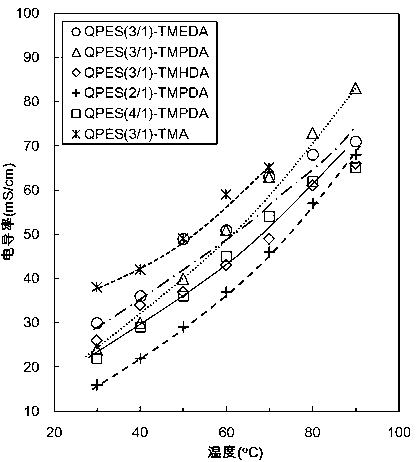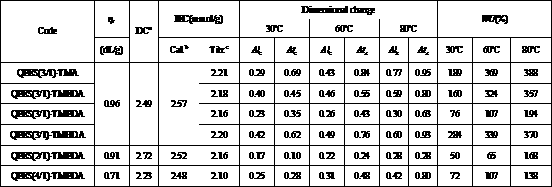Preparation method of side chain crosslinked polymer and side chain crosslinked polymer anion exchange membrane of side chain crosslinked polymer
An anion exchange membrane and side chain cross-linking technology, which is applied in the field of preparation of side chain cross-linked polymers and side chain cross-linked polymer anion exchange membranes, can solve the problem that the dimensional stability of ion conductivity is not very good Improvement and other issues, to achieve the effect of controllable ion exchange capacity, simple synthesis process, and high ion conductivity
- Summary
- Abstract
- Description
- Claims
- Application Information
AI Technical Summary
Problems solved by technology
Method used
Image
Examples
preparation example Construction
[0050] The preparation method of the side chain cross-linked polyethersulfone anion exchange membrane involved in the present invention, by adjusting the aromatic dihydric phenol (II) with the side chain chloromethylation reactive group and the non-reactive group The ratio of aromatic dihydric phenol (III) can be used to change the rigidity of the polymer main chain and the length of the chain segment, and the degree of chloromethyl substitution of the polymer can be controlled by changing the amount of Friedel-Crafts reaction catalyst, reaction temperature and time. Based on the structure of the group dihalide (I) and aromatic dihydric phenol (III), different types of chloromethylated polyethersulfone polymers (CMPES) were obtained through polymerization and Friedel-Crafts reactions; and then different types of CMPES The film is cast, and an anion exchange membrane is formed by changing the structure of the tertiary diamine crosslinking agent (IV) and the molar ratio with chlo...
Embodiment 1
[0091] Embodiment 1: Preparation of side chain cross-linked quaternized anion exchange membrane QPES(2 / 1)-TMPDA
[0092] Preparation of PES (2 / 1) polymer: Add 1.524g of DFDPS (6mmol) in a completely dry four-neck flask equipped with nitrogen inlet and outlet devices, oil-water separator, and separatory funnel under nitrogen protection , 18 mL of NMP, 1.401 g of BHPF (4 mmol), 0.672 g of HFBPA (2 mmol), 0.954 g of potassium carbonate (6.9 mmol), and 18 mL of toluene. Slowly ramp up to 140 o C was refluxed for 4h, and the moisture generated by the reaction was removed in the form of toluene / water azeotrope. Then the temperature is slowly raised to 170 o C, keep the temperature constant for 6h. After the reaction was over, the heating was stopped and cooled to room temperature. The product was slowly poured into about 500 mL of deionized water, and a white fibrous polymer product was precipitated. The product was thoroughly washed with deionized water at 80 o C dried in a v...
Embodiment 2
[0096] Example 2: Preparation of side chain cross-linked quaternized anion exchange membrane QPES(2 / 1)-TMEDA
[0097] Similar to the preparation method of QPES(2 / 1)-TMPDA in Example 1, the difference is that the aromatic dihalide monomer in Example 2 is changed to 4,4'-dichlorodiphenyl sulfone, tertiary di The amine monomer TMPDA was changed to TMEDA.
PUM
| Property | Measurement | Unit |
|---|---|---|
| thickness | aaaaa | aaaaa |
| thickness | aaaaa | aaaaa |
Abstract
Description
Claims
Application Information
 Login to View More
Login to View More - R&D
- Intellectual Property
- Life Sciences
- Materials
- Tech Scout
- Unparalleled Data Quality
- Higher Quality Content
- 60% Fewer Hallucinations
Browse by: Latest US Patents, China's latest patents, Technical Efficacy Thesaurus, Application Domain, Technology Topic, Popular Technical Reports.
© 2025 PatSnap. All rights reserved.Legal|Privacy policy|Modern Slavery Act Transparency Statement|Sitemap|About US| Contact US: help@patsnap.com



